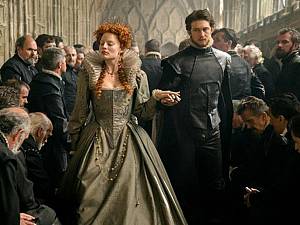Movie Review: Mary Queen of Scots
 Focus FeaturesWho knew that 16th Century Scotland was so very much like our own time and place? At the rather grim court of the Scottish Queen Mary (Saoirse Ronan), we encounter an unexpected ethnic diversity (there are nobles of color) and a surprisingly up-to-date view of gender. (Addressing a transvestite man cavorting among the ladies of the bedchamber, Mary says, “Be whoever you would be with us. You make for a lovely sister.”)
Focus FeaturesWho knew that 16th Century Scotland was so very much like our own time and place? At the rather grim court of the Scottish Queen Mary (Saoirse Ronan), we encounter an unexpected ethnic diversity (there are nobles of color) and a surprisingly up-to-date view of gender. (Addressing a transvestite man cavorting among the ladies of the bedchamber, Mary says, “Be whoever you would be with us. You make for a lovely sister.”)
Maybe this is the way it was back then—I haven’t read Professor John Guy’s biography of Mary Stuart, upon which Beau Willimon (House of Cards) based his screenplay for Mary Queen of Scots. But it is a historical fact that Mary never met the English Queen Elizabeth I, her cousin and reluctant antagonist—and yet the two women do confront one another in this movie. Which is fine by me, since the scene in which they finally come face to face, in a room that’s oddly but dramatically filled with wafting white curtains, is the best scene in the picture.
Until that point, which comes toward the end of the movie, we spend most of our time with Ronan’s Mary—a spunky teen on first sighting, newly arrived at Edinburgh’s Holyrood Palace after being largely raised in France—with intermittent cutaways to the court of Elizabeth (Margot Robbie) down in England. This way of structuring the story may have been necessary, but it’s frustrating: when your cast includes two actors of Ronan’s and Robbie’s gifts, you want to see them working off each other. (Also frustrating is the movie’s production design, which has the virtue of being insistently suggestive of its period—lots of gray stone castle walls and dim interiors—but also the drawback of a mounting monotony.)
Although they appear separately for most of the movie, Rona and Robbie are both compelling on their own. Mary, a Catholic returned to Protestant Scotland to claim her throne in the face of a resistance led by beardy religious firebrand John Knox (David Tennant), is unambiguously defiant. Since she has a persuasive claim to the English throne as well, she’s also a major concern for the Protestant Elizabeth, who is held to be an illegitimate ruler by her nation’s Catholics.
There’s a lot of that history stuff, no surprise. But the director, English theatre veteran Josie Rourke, making her first feature, uses the complex tale of Mary’s inescapable doom as a ground for lowkey observations. Although the female protagonists here are both monarchs, Rourke’s visual compositions—showing each queen surrounded at most times by male courtiers, many of them devious—wordlessly demonstrate how constrained their power really is. (The director also creates memorable images of Elizabethan menstrual and childbirth practices; and Robbie—a paragon of artistic commitment—spends most of the movie obscured beneath an impasto of facial blisters, to depict the aftermath of Elizabeth’s bout with the then-common scourge of smallpox.)
Mary was already once-widowed (her very brief marriage to the French King Francis II ended when he did, after contracting a brain abscess). Now she is determined to remarry and produce a royal heir—which would be another threat to Elizabeth, who has no husband or children and appears quite content in their absence. Mary settles on Lord Darnley (Jack Lowden)—a treacherous worm, as it turns out. She finds him in bed with the aforementioned transvestite, but it doesn’t matter: she manages to get pregnant by him anyway. “With Heaven’s blessing we bring another Stuart into this world,” she says, “to rule over Scotland and England.” (This in fact is what happened, although too late to bring Mary any joy.)
The two queens occasionally communicate by letter. “We both have nobles who would have us deposed,” Mary says in one. After an advisor warns her that “the people believe you are a traitor and a whore,” and it becomes clear that the end of her Scottish reign is at hand, we hear Elizabeth musing to one of her own counselors, “Are we to do nothing as my sister is deposed?” But this reg al felicity has limits. When Mary flees Scotland to seek refuge in England, the cautious Elizabeth orders her arrested and keeps her imprisoned for the next 19 years, before having her beheaded at Fotheringhay Castle in 1587, at the age of 44. You may not pretend to be surprised by this.